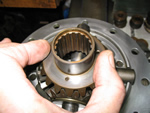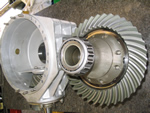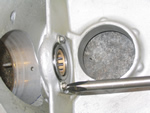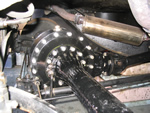





Please be aware that we offer a full half shaft & wheel bearing rebuilding service. Please contact us for details.
Instructions for fitting of modified rear wheel bearing RG5365P
The conversion mentioned below is suitable for use with the following half shafts:
All Bentley / Silver Dawn models - RH shaft RG4346, LH shaft RG4345
Silver Wraith SWB models - RH shaft RG 3192, LH shaft GB 4635.
It is surprising how long the axle will hold out, but the only problem is that when it does go bang there is so much damage that the cost is very high. If a rear wheel bearing has actually failed, that is the bearing has failed on the road in a collapsed state, there is no doubt at all that the relevant rear outer axle bearing, on the failed wheel bearing side, has been affected. It is in fact impossible for such a wheel bearing total collapse to not have caused some axle long term damage.
The initial failure of the wheel bearing is usually the breakage of the bearing cage, which separates the balls within the bearing. If the owner is lucky he/she hears a clicking, which sometimes disappears temporarily when the car is reversed. Unless the bearings are really badly worn it can be difficult to detect actual wear when the car is jacked up with the load relieved from the bearing and when the wheels are spun. In fact it is much easier to detect the wear when the wheel is removed as any imperfect movement of the bearing is hidden by the heavy flywheel effect of the road wheel. Once the wheel is removed it becomes necessary to have a good ear and light touch, rotating the hub back and forth feeling and listening for noise and roughness. Along with this back and forth movement the half shaft needs continually indexing around to cover the full 360 degrees of the bearing.
As the tooling and spares are not easily obtainable when out on the road, it is advisable to renew the rear wheel bearings unless the owner knows for sure that the bearings have been changed. Failing that, at least check the rear wheel bearings most thoroughly for any signs of wear.
Initial failure is often caused by sudden cage breakage. The narrow part of the cage separating each ball wears very thin, it breaks, initially there is no noise, two balls catch up with each other and the process continues at a pace. Very quickly the balls are nearly all on one side of the bearing allowing the bearing tracks to run off parallel with each other. At 50 / 60 mph the rest is history!
The other mode of rear wheel bearing failure is when the grease no longer lubricates and / or condensation has enter the bearing, resting at the bottom, it firstly erodes the track quickly followed by erosion of the balls. The rough balls either further carve up the tracks or the balls cut through the cage. Incidentally the main axle bearings also suffer this condensation erosion, usually on the right side where the inside of the vertical axle case (this part of the case cannot be seen) channels the water directly to the bearing. It does not happen so frequently on the left side as the axle side plate which carries the bearing on this side (this plate can be seen externally) is tapered and usually directs water away from the bearing. In this mode the initial roughness of either the wheel bearing or axle bearing can be felt when driving; it is usually mistaken for flat spots on the tyres for the first five miles or so. It will sometimes persist for many more miles as the wear takes place. From the drivers view point the problem appears to disappear because, when the axle is warm, the spring that pre-loads the right-hand axle bearing allows the axle bearing to move in and out each time a worn section of the bearing comes on load. This spring also moves in sympathy to disguise or mask a worn rear wheel bearing. The driver naturally believes the flat spots on the tyres have been relieved as the car attains more mileage. There is however a degree of vibration still present from the rear end normally detected through the floor pan. Unfortunately by the time a driver actually hears or feels either a rear wheel bearing or axle bearing the damage is done.
History
Two types of rear wheel bearing were used in production and the half shafts were also of different diameter at the bearing location, as was the bearing housing. The very early types were only used on A & B series Bentley MkVI models. The changeover to the later bearing arrangement started circa Feb 1948 and the later bearings, bearing housings and half shafts can be used on the earlier cars.
The conversion mentioned below is suitable for use with the following half shafts:
All Bentley / Silver Dawn models - RH shaft RG4346, LH shaft RG4345
Silver Wraith SWB models - RH shaft RG 3192, LH shaft GB 4635.
The original rear wheel bearings are still available but very expensive. This original bearing is capable of taking side thrust loads and any replacement type must be a thrust bearing, a normal roller bearing will quickly fail.
The usual disclaimers apply when a non-original bearing is utilised.
NOTE. The bore of both bearing and collar MUST be lubricated with engine oil before being pressed onto the half shaft.
| << Previous Page | Next Page >> |